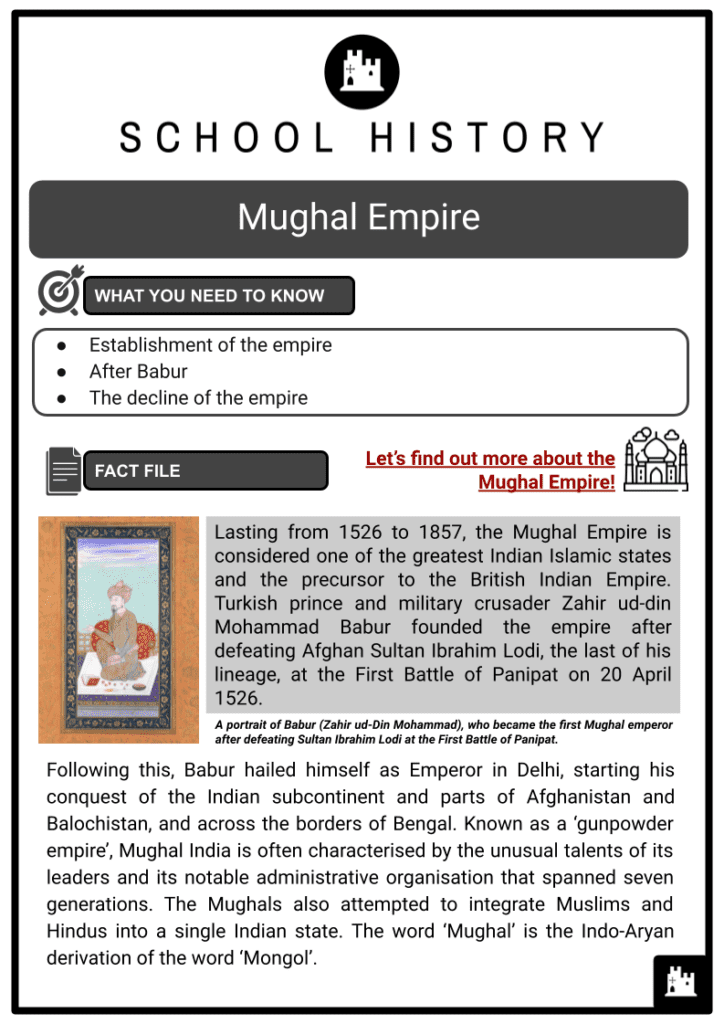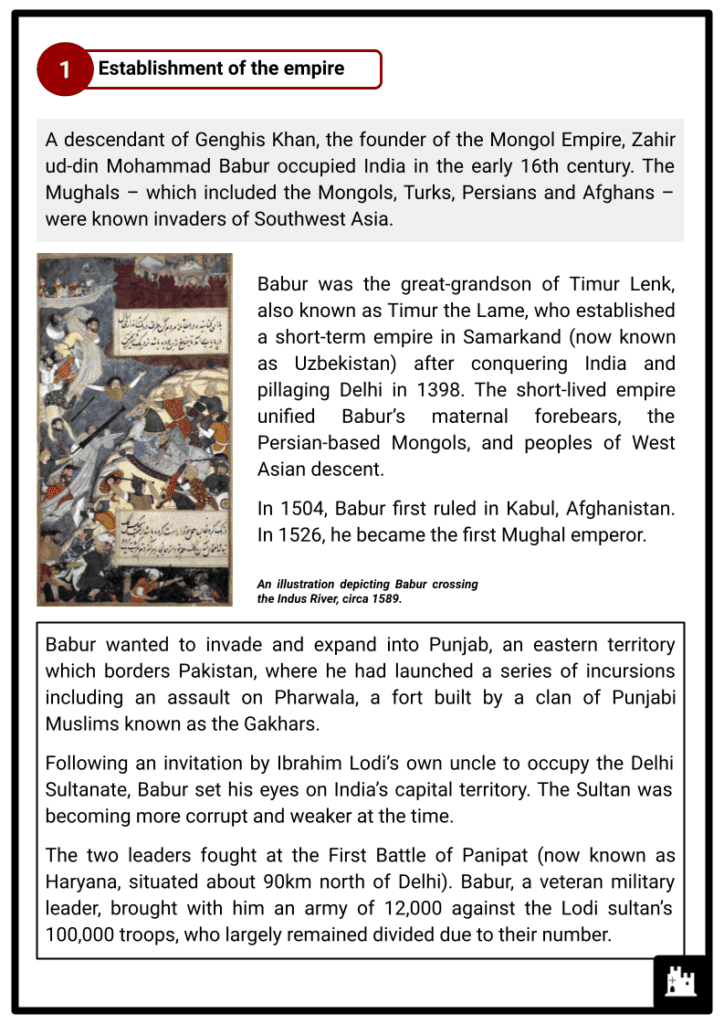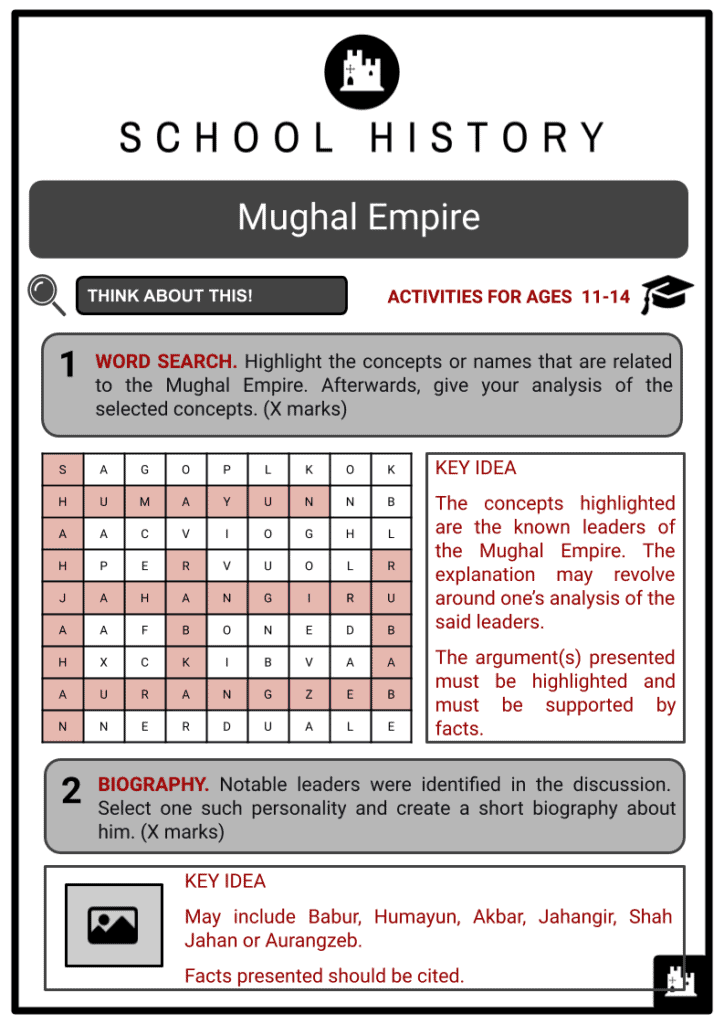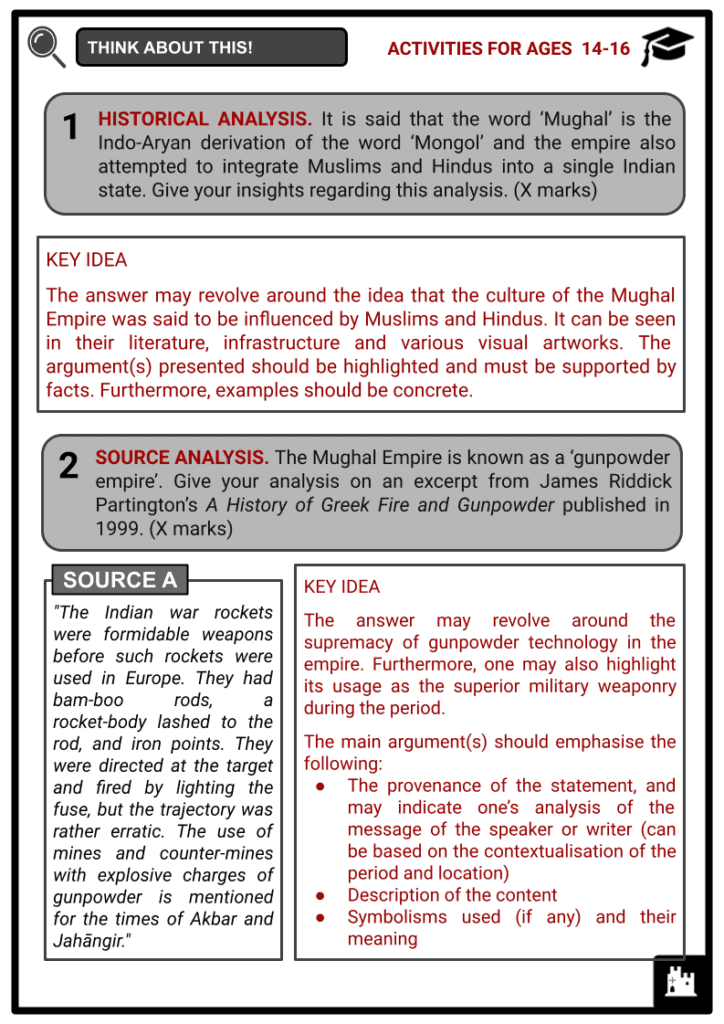Mughal Empire Worksheets
Do you want to save dozens of hours in time? Get your evenings and weekends back? Be able to teach about the Mughal Empire to your students?
Our worksheet bundle includes a fact file and printable worksheets and student activities. Perfect for both the classroom and homeschooling!
Summary
- Establishment of the empire
- After Babur
- The decline of the empire
Key Facts And Information
Let’s find out more about the Mughal Empire!
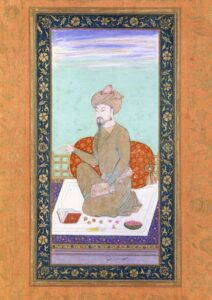
Lasting from 1526 to 1857, the Mughal Empire is considered one of the greatest Indian Islamic states and the precursor to the British Indian Empire. Turkish prince and military crusader Zahir ud-din Mohammad Babur founded the empire after defeating Afghan Sultan Ibrahim Lodi, the last of his lineage, at the First Battle of Panipat on 20 April 1526.
Following this, Babur hailed himself as Emperor in Delhi, starting his conquest of the Indian subcontinent and parts of Afghanistan and Balochistan, and across the borders of Bengal. Known as a ‘gunpowder empire’, Mughal India is often characterised by the unusual talents of its leaders and its notable administrative organisation that spanned seven generations. The Mughals also attempted to integrate Muslims and Hindus into a single Indian state. The word ‘Mughal’ is the Indo-Aryan derivation of the word ‘Mongol’.
Establishment of the empire
- A descendant of Genghis Khan, the founder of the Mongol Empire, Zahir ud-din Mohammad Babur occupied India in the early 16th century. The Mughals – which included the Mongols, Turks, Persians and Afghans – were known invaders of Southwest Asia.
- Babur was the great-grandson of Timur Lenk, also known as Timur the Lame, who established a short-term empire in Samarkand (now known as Uzbekistan) after conquering India and pillaging Delhi in 1398. The short-lived empire unified Babur’s maternal forebears, the Persian-based Mongols, and peoples of West Asian descent. In 1504, Babur first ruled in Kabul, Afghanistan. In 1526, he became the first Mughal emperor.
- Babur wanted to invade and expand into Punjab, an eastern territory which borders Pakistan, where he had launched a series of incursions including an assault on Pharwala, a fort built by a clan of Punjabi Muslims known as the Gakhars. Following an invitation by Ibrahim Lodi’s own uncle to occupy the Delhi Sultanate, Babur set his eyes on India’s capital territory. The Sultan was becoming more corrupt and weaker at the time.
- The two leaders fought at the First Battle of Panipat (now known as Haryana, situated about 90km north of Delhi). Babur, a veteran military leader, brought with him an army of 12,000 against the Lodi sultan’s 100,000 troops, who largely remained divided due to their number.
- Babur decisively won the battle through the help of gun carts, movable artillery and top of the range cavalry methods. He then emerged victorious against a Rajput confederacy ruled by Rana Sangha a year after.
- In 1529, Babur successfully subjugated the combined army of Afghans and the sultan of Bengal. A year later, he died failing to solidify his military gains. Baburnama, Babur’s book of memoirs, was one of his legacies, as were the beautiful gardens in Kabul and Lahore. His descendants would later continue the rule of the Mughal Empire over the Indian subcontinent.
After Babur
- Babur’s son Humayun (1530–1556) ascended to the Delhi throne following the former’s death. However, the new ruler was faced with feuds over his own succession, a contention of Afghan claims, and the Afghan-Rajput resistance that trooped into the Indian capital in 1540.
- Humayun then fled to Persia (modern-day Iran) and lived at the Safavid court of Tahmasp I for almost ten years. To solve the disputes, an imperial unification and administrative framework were established during the reign of Afghan leader Sher Shah, although it was only in Akbar the Great’s time that the measures were developed.
- Through the help of the Safavid forces, Humayun established a foothold in Kabul in 1545 and reasserted his right to the Delhi throne, which was made easier by Sher Shah’s death in May of that year, resulting in Humayun’s successful rule in Delhi by 1555. A year later, he fell down his library’s stairs, leading to his demise.
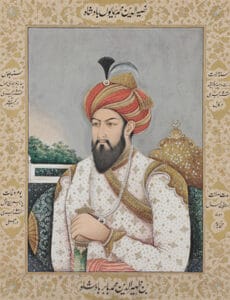
Portrait of Humayun - Next in line to the throne was Humayun’s 13-year-old son Jalal-ud-Din Akbar (1556–1605). Imperial expansion under regent Bayram Khan continued shortly after the victory at the Second Battle of Panipat in 1556. But when Akbar came of age, he immediately distanced himself from the influence of ministers and imperial court officials. Akbar then saw the development of his administrative policies, which became the framework of the Mughal Empire for over 200 years.
- Moreover, he invaded far-flung territories bordered by Kabul in the northwest, Kashmir in the north, Bengal in the east, and beyond the Narmada River in central India.
- Beginning in 1571, Akbar established the Fatehpur Sikri, also known as the ‘town of victory’, a walled capital near the Indian city of Agra. Built in the capital were the palaces dedicated to his senior queens, a huge artificial lake, and lavish water-filled courtyards. It also included the tomb of Sufi, the saint he revered, as well as the tomb of Shaikh Salim Chisti (1418–1572), who had foreseen his son’s birth.
- Unfortunately, Fatehpur Sikri did not last long as the capital was moved to Lahore in 1585. Historians said it may have been due to the inadequate water supply in the city or the fact that Akbar needed to oversee his territories in the northwest, and therefore moved his capital to the area. But in 1599, Akbar moved the capital back to Agra, where he ruled until his demise.
- In terms of cultural leadership, Akbar established reconciliation and assimilation policies for Hindus, who made up the population’s majority. Hindu chiefs were recruited and offered the highest government positions. Intermarriages between the Mughal and Rajput aristocracies were also allowed. New temples were built. The jizya, a poll tax imposed on non-Muslims, was likewise outlawed.
- Similarly, Akbar introduced a new religion called Din-i-Ilahi, the so-called Divine Faith, which espouses the theory of ‘rulership as a divine illumination’ and the acceptance of all religions and sects. Sati, the practice in which widows had to commit suicide on their husband’s funeral pyre, was also abolished. Akbar then allowed widows to remarry and averted child marriage. Furthermore, women were granted the opportunity to work in the market.
- In terms of education, Akbar built imperial libraries that incorporated books from various languages: Hindi, Persian, Greek, Kashmiri, English and Arabic, including the Shahnameh, Bhagavata Purana and the Bible. Regular dialogues and debates were also held at Fatehpur Sikri, inviting Jesuit missionaries from Goa to Akbar’s court. The Hamzanama, a masterpiece composed of 1,400 huge paintings, was also created during Akbar’s reign.
- Due to these cultural and economic policies, the Mughal Empire accumulated a total revenue of 17.5 million pounds in 1600, which surpassed Great Britain’s entire treasury with its revenue of 16 million pounds in 1800.
- Then came the reigns of Jahangir (1605–1627) and Shah Jahan (1628–1658). During Jahangir’s time, his Persian wife Mehr-Un-Nissa, whom he renamed Nur Jahan, which means ‘light of the world’, also rose to power and became influential in the imperial court. Because of this, Persian officers, scholars, artists and poets became more involved in Mughal India. Persian representation also supposedly upset the court’s impartiality.
- While Jahangir adored Hindu festivals, he also encouraged mass conversion to Islam. The Emperor also allowed the persecution of followers of Jainism and ordered the killing of Guru Arjun Dev, the Sikhs’ fifth saint-teacher. Guru Arjun was a known supporter of Prince Khursaw, an heir to the Mughal throne who participated in the civil war that occurred following Akbar’s passing.
- In 1620, 52 Hindu princes were released from captivity, which signifies the importance of the Sikhs’ Diwali festival. Two years later, Shah Jahan revolted against Nur Jahan due to the latter’s attempts to secure the Mughal throne for the prince of her liking. It was also the time when the empire lost Kandahar in southern Afghanistan to the Persian forces.
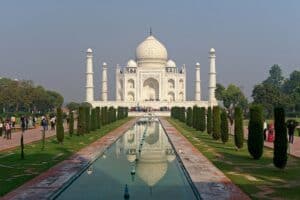
The Taj Mahal, the world-famous monument built by Shah Jahan for his beloved wife Mumtaz Mahal. Both a symbol of Mughal artistry and lavishness. - Jahangir also allowed Sir Thomas Roe, the ambassador of King James I, to establish a factory by the British East India Company at Surat, which would later contribute to the empire’s decline. Following this, Shah Jahan led Mughal forces to invade the Deccan and territories beyond the Khyber Pass from 1636 to 1646. This campaign almost bankrupted the imperial treasury. Shah Jahan likewise directed the creation of the Peacock Throne, embellished with 108 rubies, 116 emeralds, and rows of pearls.
- In Agra, Shah Jahan had the Taj Mahal built as a tomb for Mumtaz Mahal, his beloved wife. Besides being the symbol of Mughal artistry, the monument also signifies lavishness in times of financial crisis.
The decline of the empire
- By the time Aurangzeb succeeded the Mughal throne, the empire was already showing signs of decline. The gunpowder technology was no longer the superior military weaponry and corruption became more evident. Prevailing policies that maintained good relations with non-Muslims were revoked. Aurangzeb then imposed Islamic laws on Hindus and had many temples destroyed.
- From 1688–1691, Aurangzeb defeated the British. However, the latter’s victory over the French at the 1757 Battle of Plassey resulted in Great Britain’s eventual rule in Bengal. The British then expanded from Serat and established trading stations in what was later known as the three Presidencies: Calcutta, Madras and Bombay.
- Because of a royal decree issued by Emperor Farrukhsiyar in 1717, the British were also exempted from customs duties. Moreover, the British, on behalf of the Emperor, were able to collect taxes due to the treaty of 1765, leading to land control as taxation was connected to land ownership.
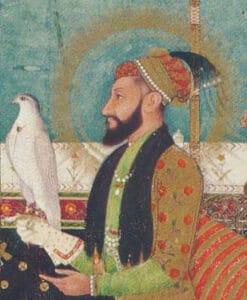
A painting depicting Aurangzeb - While Great Britain continued to seize power, Aurangzeb engaged in protracted wars, including disputes against the Pathans in Afghanistan, the sultans of Bijapur and Golconda in the Deccan, the Marathas in Maharashtra, and the Ahoms in Assam. Regional leaders also began to distance themselves from the declining empire and built their own kingdoms.
- By the mid-19th century, Great Britain had already gained control of vast Mughal Empire territories through numerous treaties and alliances. From 1848–1856, the British annexed more than six states, leading to social unrest.
- By 1857, uprisings in the Sepoy army took place. The sepoys successfully seized Delhi, declaring Bahadur Shah II ‘the emperor of all India’. They also captured Agra, prompting the British to retreat into the Red Fort, as well as the city of Lucknow. This series of revolts later became known as the Indian Mutiny, marking the demise of the Mughal Empire.
Image Sources
- https://upload.wikimedia.org/wikipedia/commons/thumb/7/77/Emperor_babur.jpg/640px-Emperor_babur.jpg
- https://commons.wikimedia.org/wiki/File:Humayun_Emperor.jpg
- https://commons.wikimedia.org/wiki/File:20191204_Taj_Mahal_Agra_0622_6533_DxO.jpg
- https://commons.wikimedia.org/wiki/File:Aurangzeb-portrait.jpg

